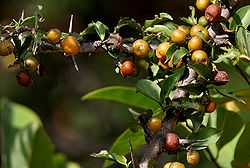Vanguerieae
| Vanguerieae | |
|---|---|
 | |
| Canthium coromandelicum | |
| Scientific classification | |
| Kingdom: | Plantae |
| Clade: | Angiosperms |
| Clade: | Eudicots |
| Clade: | Asterids |
| Order: | Gentianales |
| Family: | Rubiaceae |
| Subfamily: | Ixoroideae |
| Tribe: | Vanguerieae A.Rich. ex Dumort. |
Vanguerieae is a tribe of flowering plants in the Rubiaceae family and contains about 600 species in 26 genera. The tribe is a common and important constituent of many different kinds of habitats. Species of Vanguerieae are found in both extremely wet habitats, such as the rain forests of tropical Africa, and in the very dry desert-like areas of the horn of Africa and of the southernmost part of Madagascar. The tribe is represented at altitudes of over 2,000 m (6,600 ft) in the mountains of Malawi and Tanzania, but also at sea-level along the coast of South Africa. This wide distribution is accompanied by a wide range of morphological adaptations. Several different life forms such as geofructices (plants with woody, underground stems), shrubs, trees, and climbers are represented. There is also a wide range of flower sizes and fruit morphologies, suggesting different adaptations to pollination and dispersal. Most of the species are probably pollinated by insects, but it is suspected that at least some of the large-flowered species of Fadogia are bird-pollinated. The edibility of many fruits suggests that they are dispersed by animals. Vangueria madagascariensis or Spanish tamarind is grown for its tasty fruits and is the only species that is used by man to any great extent.
Genera
Currently accepted names
- Afrocanthium (Bridson) Lantz & B.Bremer (17 sp)
- Bullockia (Bridson) Razafim., Lantz & B.Bremer (6 sp)
- Canthium Lam. (101 sp)
- Cuviera DC. (10 sp)
- Cyclophyllum Hook.f. (37 sp)
- Eriosemopsis Robyns (1 sp)
- Everistia S.T.Reynolds & R.J.F.Hend. (1 sp)
- Fadogia Schweinf. (40 sp)
- Fadogiella Robyns (3 sp)
- Globulostylis Wernham (8 sp)
- Hutchinsonia Robyns (2 sp)
- Keetia E.Philipps (32 sp)
- Meyna Roxb. ex Link (10 sp)
- Multidentia Gilli (9 sp)
- Peponidium (Baill.) Arènes (47 sp)
- Perakanthus Robyns ex Ridl. (1 sp)
- Plectroniella Robyns (1 sp)
- Psydrax Gaertn. (80 sp)
- Pygmaeothamnus Robyns (2 sp)
- Pyrostria Comm. ex A.Juss. (59 sp)
- Robynsia Hutch. (1 sp)
- Rytigynia Blume (81 sp)
- Temnocalyx Robyns (1 sp)
- Vangueria Juss. (58 sp)
- Vangueriella Verdc. (18 sp)
- Vangueriopsis Robyns (5 sp)
Synonyms
- Ancylanthos Desf. = Vangueria
- Clusiophyllea Baill. = Canthium
- Dinocanthium Bremek. = Pyrostria
- Dondisia DC. = Canthium
- Lagynias E.Mey. ex Robyns = Vangueria
- Leroya Cavaco = Pyrostria
- Lycioserissa Roem. & Schult. = Canthium
- Mesoptera Hook.f. = Psydrax
- Mitrastigma Harv. = Psydrax
- Neoleroya Cavaco = Pyrostria
- Pachystigma Hochst. = Vangueria
- Phallaria Schumach. & Thonn. = Psydrax
- Plectronia Lour. = Canthium, Peponidium, Psydrax
- Pseudopeponidium Homolle ex Arènes = Pyrostria
- Psilostoma Klotzsch ex Eckl. & Zeyh. = Canthium
- Rhopalobrachium Schltr. & K.Krause = Cyclophyllum
- Scyphochlamys Balf.f. = Pyrostria
- Tapiphyllum Robyns = Vangueria
- Vavanga Rohr = Vangueria
Phylogeny
The following phylogenetic tree is based on molecular phylogenetic studies of DNA sequences.[1][2][3][4][5][6]
| Vanguerieae |
| |||||||||||||||||||||||||||||||||||||||||||||||||||||||||||||||||||||||||||||||||||||||||||||||||||||||||||||||
| |
References
- ↑ Lantz H, Bremer B (2004). "Phylogeny inferred from morphology and DNA data: characterizing well-supported groups in Vanguerieae (Rubiaceae)". Botanical Journal of the Linnean Society 146 (3): 257–283. doi:10.1111/j.1095-8339.2004.00338.x.
- ↑ Lantz H, Bremer B (2005). "Phylogeny of the complex Vanguerieae (Rubiaceae) genera Fadogia, Rytigynia, and Vangueria with close relatives and a new circumscription of Vangueria". Plant Systematics and Evolution 253: 159–183. doi:10.1007/s00606-005-0313-9.
- ↑ Razafimandimbison SG, Lantz H, Mouly A, Bremer B (2009). "Evolutionary trends, major lineages, and new generic limits in the dioecious group of the tribe Vanguerieae (Rubiaceae): insights into the evolution of functional dioecy". Annals of the Missouri Botanical Garden 96 (1): 161–181. doi:10.3417/2006191.
- ↑ Verstraete B, Janssens S, Smets E, Dessein S (2013). "Symbiotic beta-proteobacteria beyond legumes: Burkholderia in Rubiaceae". PLoS ONE 8 (1): e55260. doi:10.1371/journal.pone.0055260.
- ↑ Verstraete B, Lachenaud O, Smets E, Dessein S, Sonké B (2013). "Taxonomy and phylogeny of Cuviera (Rubiaceae-Vanguerieae) and reinstatement of the genus Globulostylis with the description of three new species". Botanical Journal of the Linnean Society 173 (3): 407–441. doi:10.1111/boj.12062.
- ↑ Verstraete B, Janssens S, Lemaire B, Smets E, Dessein S (2013). "Phylogenetic lineages in Vanguerieae (Rubiaceae) associated with Burkholderia bacteria in sub-Saharan Africa". American Journal of Botany: in press.
External links
| Wikimedia Commons has media related to Vanguerieae. |
| Wikispecies has information related to: Vanguerieae |